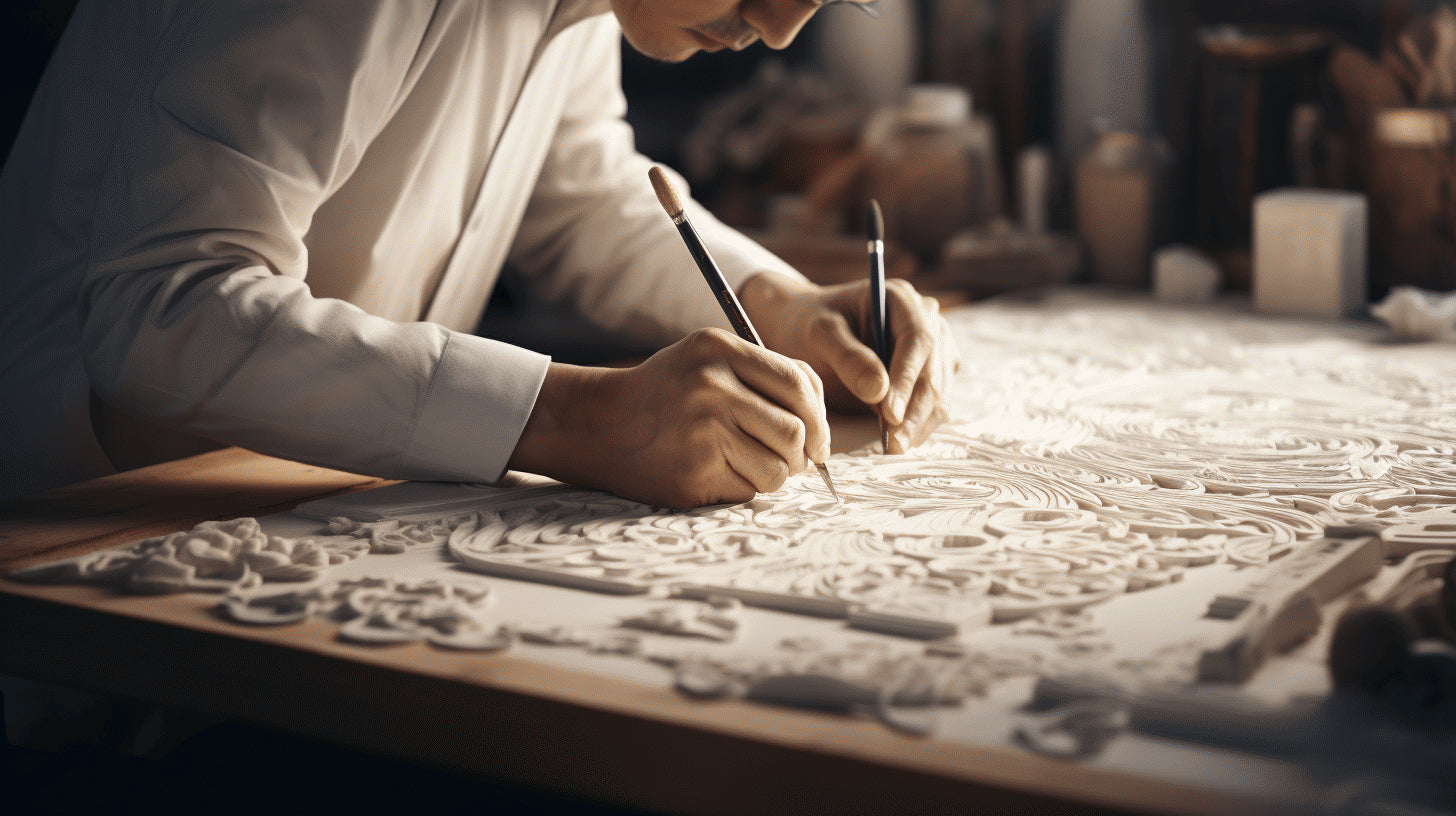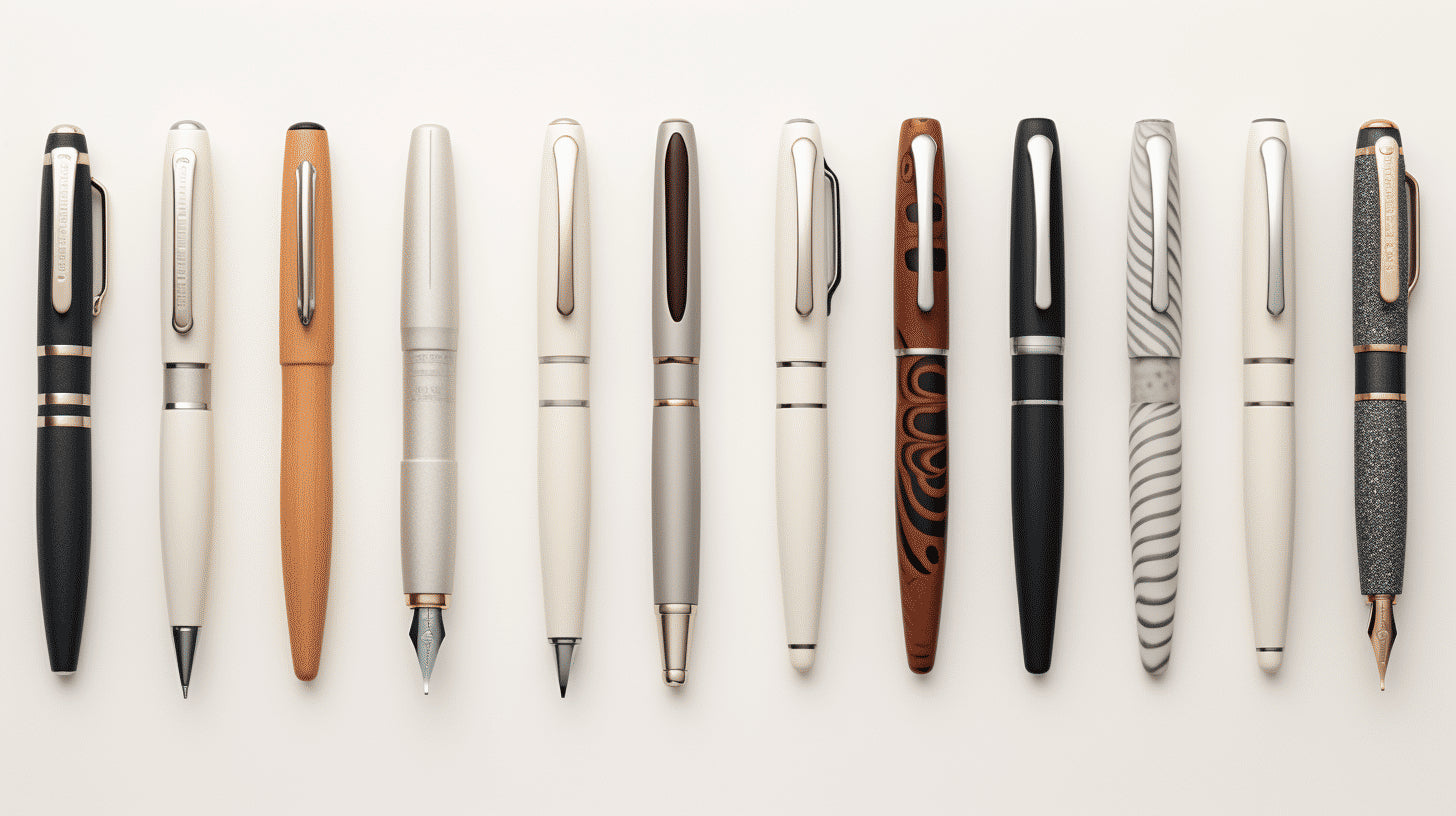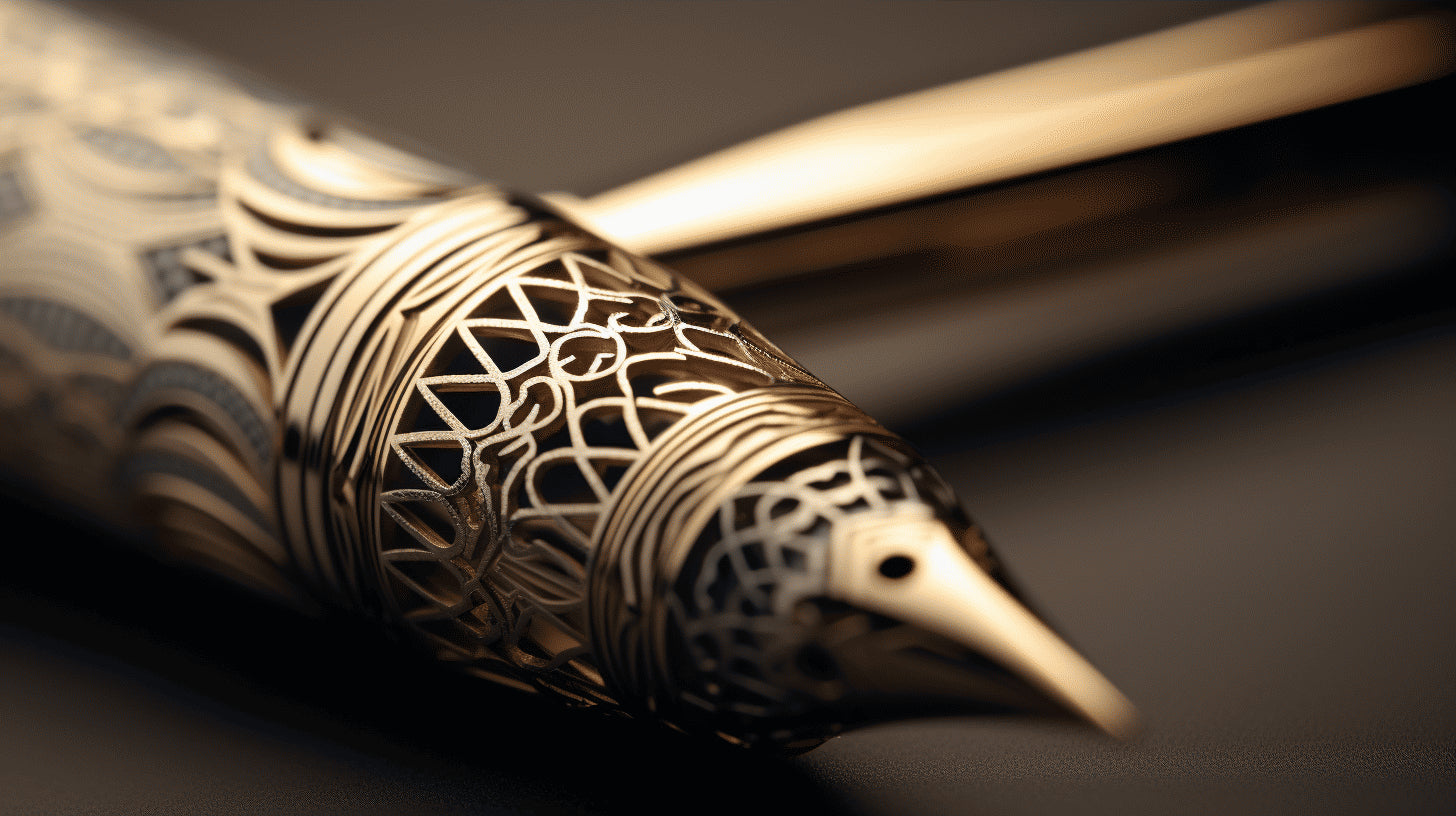
The Beauty of Handmade: Unveiling the Artistry Behind Pens
Handmade products have a charm and uniqueness that mass-produced items simply can't replicate. They possess a personal touch and attention to detail that makes them truly special. One such example of craftsmanship and artistry is seen in handmade pens. These exquisite writing instruments are created with care, skill, and passion, resulting in functional pieces of art.
In today's digital age, where typing on keyboards and touchscreen devices has become the norm, the art of handwriting with a pen can sometimes feel like a lost art. However, there is a growing appreciation for the beauty and elegance of writing with a fine pen, and handmade pens are at the forefront of this resurgence.
In this article, we will delve into the artistry and craftsmanship behind handmade pens, explore the market size and demand for these unique creations, and even take a closer look at Germany's significant influence on the fountain pen industry. So, grab a cup of coffee, sit back, and prepare to embark on a journey into the fascinating world of handmade pens.
Artistry and Craftsmanship Behind Handmade Pens
Handmade pens are more than just writing instruments; they embody the perfect fusion of artistry and craftsmanship. Each pen is a testament to the skill and dedication of the artisan who meticulously creates it. From the choice of materials to the attention to detail, every aspect of crafting handmade pens is a labor of love.
The Beauty of Handcrafted Wooden Pens
When it comes to handmade pens, wooden pens hold a special place. The allure of wooden pens lies in their natural beauty and uniqueness. The wood grain patterns and colors vary from pen to pen, making each piece truly one-of-a-kind. Crafted from a variety of exquisite woods such as maple, walnut, or rosewood, these pens not only feel great in the hand but also captivate the eye with their inherent warmth and elegance.
The Process of Craftsmanship
Crafting a handmade pen requires skill, precision, and attention to detail. It is a multistep process that involves several techniques and tools. Here's a glimpse into the craftsmanship behind the creation of a handcrafted wooden pen:
- Material Selection: The process starts with carefully selecting the wood for the pen body. Fine quality wood is chosen for its durability, grain pattern, and aesthetic appeal.
- Cutting and Shaping: The selected wood is then cut into the desired size and shape using specialized tools such as a lathe or a bandsaw. This step requires precision to achieve a uniform shape and dimensions.
- Sanding and Smoothing: The rough cut wooden pen body is sanded meticulously to remove imperfections and achieve a smooth finish. Multiple grits of sandpaper are used to gradually refine the surface, resulting in a polished and flawless appearance.
- Finishing and Polishing: Once the wooden pen body is smooth, it is time to apply a protective finish. This can involve several coats of wax, lacquer, or oil to enhance the wood's natural beauty and provide durability. After the finishing coats, the pen is polished to a high shine, giving it a luxurious look.
- Assembly: The final step involves assembling the different components of the pen, including the nib, ink cartridge, and cap. Careful attention is paid to ensure that all parts fit together seamlessly and function properly.
The Artistry in Every Handmade Pen
Beyond the technical craftsmanship, the artistry shines through in the unique design and embellishments of handmade pens. Artisans often incorporate intricate details such as hand-carved motifs, inlays, or metal accents to elevate the aesthetics of the pen. These artistic touches not only enhance the visual appeal but also add a personal touch and individuality to each pen.
Handmade Pens as Timeless Treasures
Handmade pens possess a certain charm that mass-produced pens simply cannot replicate. They carry a sense of authenticity and exclusivity, making them valuable possessions and perfect heirloom pieces. Whether used for writing or as a cherished collectible, each handmade pen tells a story and becomes a cherished companion.
In the end, the artistry and craftsmanship behind handmade pens make them much more than mere writing instruments. They are a celebration of creativity, skill, and dedication. So, the next time you hold a handmade pen in your hand, take a moment to appreciate the artistry that went into creating it.
Current Market Size and Forecast
The market for writing instruments is rapidly growing, with an estimated value of USD 17.08 billion in 2022. Experts predict that this market will continue to expand at a compound annual growth rate (CAGR) of 4.3% in the coming years[1](https://www.businesswire.com/news/home/20211020005778/en/Writing-Instruments-Market-to-Reach-USD-17.08-Billion-by-2022-Booming-E-Commerce-Industry-to-Boost-the-Market-Finds-Fact.MR). This growth can be attributed to various factors, including the increasing emphasis on education and the rise in remote work and digitalization.
Pens Market
Pens are an essential part of our daily lives, used for writing, drawing, and note-taking. The global pens market is valued at US$ 16,881.08 million in 2022 and is projected to reach US$ 20,544.79 million by 2030[2](https://www.persistencemarketresearch.com/market-research/pens-market.asp). This considerable growth can be attributed to the wide range of pens available in the market, catering to different needs and preferences.
Luxury Pen Market
For those seeking a touch of elegance and sophistication, the luxury pen market presents a tempting range of options. Valued at USD 2,457 million in 2022, this segment is expected to reach USD 2,765 million in 2023[3](https://www.businesswire.com/news/home/20210924005082/en/Luxury-Pen-Market-in-US-Post-Pandemic-Period-Competition-Analysis-and-Forecasts-for-2021-2023-Adyen-BV-Cross-Pens-International-Deluxe-Comfort-Faber-Castell). Luxury pens are not only writing instruments but also status symbols and collector's items, often adorned with precious materials and intricate designs.
Digital Pen Market
With the advancement of technology, digital pens have gained popularity among professionals and individuals alike. The digital pen market was valued at USD 2.04 billion in 2021, and it is projected to witness a remarkable CAGR of 13.3% from 2021 to 2030[4](https://www.prnewswire.com/news-releases/digital-pen-market-to-register-robust-growth-due-to-technological-advancements-in-digital-healthcare-and-education--tbrc-report-301269169.html). These pens offer the convenience of both traditional writing and digital note-taking, making them a versatile choice for those embracing the digital era.
Writing and Marking Instruments Market
The wider market for writing and marking instruments is also witnessing significant growth. In 2020, this market was estimated to be worth US$ 15.6 billion, and industry projections indicate it will reach a revised size of US$ 26.3 billion[5](https://www.globenewswire.com/news-release/2021/08/02/2270118/0/en/Global-Writing-and-Marking-Instruments-Market-to-Reach-US-26-3-Billion-by-2027.html). From basic ballpoint pens to highlighters and permanent markers, there is a growing demand for diverse writing and marking tools across various industries and educational institutions.
In conclusion, the writing instruments market, including pens, luxury pens, digital pens, and writing and marking instruments, is experiencing robust growth. With the increasing focus on education, remote work, and digitalization, the demand for these products is set to expand further in the coming years. So, whether you prefer a classic ballpoint pen, a high-end luxury pen, or a versatile digital pen, the market has something to offer for everyone.
[2]: Pens market valued at US$ 16,881.08 million in 2022, expected to reach US$ 20,544.79 million by 2030
Consumer Demand for Specialized and Personalized Products
In today's market, consumers are increasingly seeking out specialized and personalized products that cater to their unique preferences and needs. This shift in consumer behavior can be attributed to various factors, such as the desire for self-expression, the importance of individuality, and the rise of social media influence. Let's explore why this demand for specialized and personalized products has become so prominent and what it means for businesses.
The Desire for Self-Expression
In a world where everything seems standardized and mass-produced, consumers are yearning for ways to express their individuality. Whether it's through fashion, home decor, or even everyday items, people want products that reflect their personality and values. Personalization allows them to stand out from the crowd and showcase their unique identity. It's no longer enough to have the same product that everyone else has; customization is the key to making a statement.
The Importance of Individuality
In an age of social media and constant connectivity, individuality has become highly valued. People want to be seen as unique, both online and offline. Personalized products provide an opportunity to create something that is tailor-made to one's own tastes and preferences. It allows consumers to separate themselves from the masses and cement their own distinct identity.
The Rise of Social Media Influence
The influence of social media cannot be ignored when discussing consumer demand for specialized and personalized products. Platforms like Instagram and Pinterest have created a culture of visual inspiration, where users are constantly exposed to beautifully customized products. Seeing others enjoying personalized items creates a desire to have them as well, leading to increased demand.
What This Means for Businesses
This shift in consumer demand presents both challenges and opportunities for businesses. On one hand, companies need to adapt to meet the growing desire for customization or risk losing customers to competitors who do offer personalized options. On the other hand, embracing personalization can lead to increased customer loyalty and brand advocacy.
To cater to this demand, businesses can consider implementing the following strategies:
- Offering Customization Options: Provide customers with the ability to personalize their products through engravings, color choices, or other customizations. This allows them to feel connected to the product and adds value to their purchase.
- Collaborating with Artists and Artisans: Partner with artists and artisans to create limited-edition or one-of-a-kind products. This not only adds exclusivity but also highlights the craftsmanship and skill behind the creation.
- Leveraging User-Generated Content: Encourage customers to share photos and reviews of their personalized products on social media. This not only acts as free advertising but also creates a sense of community and encourages others to join in on the trend.
By understanding and embracing the growing demand for specialized and personalized products, businesses can thrive in today's competitive market. The key is to offer unique and customizable experiences that resonate with consumers' desire for self-expression and individuality.
To learn more about the enduring appeal of handcrafted wooden pens and how they cater to this demand, check out this article on the Fountain Pen Journal.
Germany’s Influence on the Fountain Pen Industry
Germany has long been celebrated for its precision engineering and craftsmanship, and the fountain pen industry is no exception. From the early beginnings of fountain pen manufacturing to the establishment of renowned brands, Germany's influence on the fountain pen industry cannot be ignored. Let's dive into the key contributions that Germany has made to this timeless writing instrument.
1. Quality Craftsmanship
German fountain pen manufacturers are known for their commitment to precision and quality. German craftsmen pay meticulous attention to detail, ensuring that each pen is meticulously crafted to perfection. From the nib to the barrel, every element of a German fountain pen reflects the dedication and skill of its makers.
2. Nib Expertise
One of the highlights of German fountain pens is their exceptional nibs. German manufacturers have honed their expertise in creating nibs that offer a smooth and consistent writing experience. German-made nibs are often praised for their durability, flexibility, and ability to adapt to the writer's hand, making them a favorite among fountain pen enthusiasts around the world.
3. Innovative Designs
German fountain pen brands have consistently pushed the boundaries of innovation, introducing unique and groundbreaking designs. From the iconic Bauhaus-inspired aesthetics to modern and ergonomic shapes, German fountain pens encompass a wide range of styles that cater to different tastes and preferences. German manufacturers are known for seamlessly blending form and function, resulting in pens that not only perform exceptionally but also captivate with their visual appeal.
4. Heritage Brands
Germany is home to some of the most esteemed and iconic fountain pen brands in the world. Companies like Montblanc, Pelikan, and Faber-Castell have been shaping the industry for decades with their rich history and legacy. These heritage brands not only carry the tradition of German craftsmanship but also continue to innovate and set industry standards.
5. Technical Advancements
Germany has contributed significantly to the technical advancements in fountain pen technology. From the invention of piston fillers to the development of advanced ink flow systems, German manufacturers have consistently pushed the boundaries of what is possible in fountain pen design. These technical advancements have not only enhanced the writing experience but also improved the overall functionality and convenience of using fountain pens.
Germany's influence on the fountain pen industry cannot be overstated. The country's commitment to quality craftsmanship, expertise in nib making, innovative designs, heritage brands, and technical advancements have elevated German fountain pens to a league of their own. Whether you're a seasoned collector or a casual enthusiast, exploring the world of German fountain pens is sure to be a captivating journey.
Conclusion
In conclusion, the beauty and artistry behind handmade pens cannot be overstated. These exquisite writing instruments are crafted with precision and passion, creating a truly unique and personalized writing experience. The current market for pens, particularly luxury and specialized ones, continues to thrive, driven by the increasing demand for unique and personalized products. Germany has consistently been a key player in the fountain pen industry, with a rich history of craftsmanship and innovation.
At Wood Fountain Pens, we understand and celebrate the allure of these handcrafted treasures. Our wooden fountain pens are meticulously crafted by hand, combining elegance and functionality to elevate your writing experience. With our pens, you can embrace the artistry and precision that goes into every stroke, and truly enjoy the beauty of writing. Visit our website to explore our collection of Wood Fountain Pens and discover the joy of writing like never before.
Frequently Asked Questions
-
What makes handmade pens unique?
Handmade pens are unique because they are crafted individually by skilled artisans. Each pen is made with attention to detail, using high-quality materials, and often incorporates intricate designs or personalizations.
-
What materials are commonly used in handmade pen making?
Common materials used in handmade pen making include exotic woods, acrylic resins, metals like brass or copper, and even natural materials like bone or antler. These materials are carefully selected to ensure durability and aesthetic appeal.
-
Why should I choose a handmade pen over a mass-produced one?
Choosing a handmade pen allows you to own a unique piece of artistry. These pens are crafted with passion and dedication, resulting in superior quality and attention to detail that is often lacking in mass-produced pens. Handmade pens are also great conversation starters and make for thoughtful gifts.
-
How do handmade pens contribute to sustainability?
Handmade pens often utilize reclaimed or upcycled materials, minimizing waste and reducing their environmental impact. Additionally, supporting artisans who create handmade pens promotes sustainable practices and the preservation of traditional craftsmanship.
-
Are handmade pens more expensive than mass-produced ones?
Handmade pens are typically more expensive than mass-produced ones due to the time, effort, and skill involved in their creation. However, the unique craftsmanship and quality of these pens make them a worthwhile investment for pen enthusiasts and those looking for a special writing instrument.







Leave a comment
This site is protected by hCaptcha and the hCaptcha Privacy Policy and Terms of Service apply.